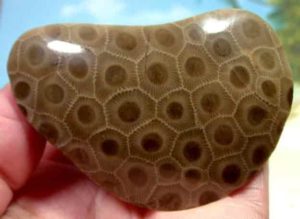
Petoskey stone
A Petoskey Stone is a rock and a fossil composed of a fossilized rugose coral, Hexagonaria percarinata, which is often pebble-shaped. Such stones were formed as a result of glaciation, where sheets of ice plucked stones from the bedrock, grinding off their rough edges and depositing them in the lower peninsula of Michigan’s northwest (and some in the northeast). Complete fossilized coral heads can be found in the source rocks for the Petoskey stones in the same areas of Michigan.
Petoskey stones are found in the Traverse Group’s Gravel Point Formation. They are fragments of an originally deposited coral reef during the Devonian period. When dry, the stone resembles ordinary calcareous but the distinctive mottled pattern of six-sided coral fossils emerges when wet or polished using lapidary techniques. It is sometimes turned into objects of decoration. There are also other forms of fossilized coral in the same location.
It was named Michigan’s state stone in 1965.
Where Is Petoskey Stone Found?
Petoskey stones can be found in Michigan on different beaches and inland locations, with many of the most popular being those around Petoskey and Charlevoix. During the winters, the frozen lake ice movement acting on the shore is thought to turn over stones at the shore of Lake Michigan, exposing new Petoskey stones at the edge of the water every spring.
Also present in the fossil records of Iowa, Indiana, Illinois, Ohio, New York and locations in Canada, Germany, England, and Asia is the type of coral that forms the basis of Petoskey Stones.










